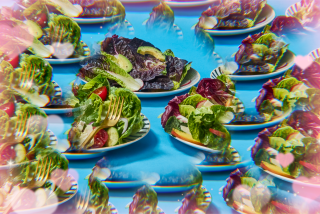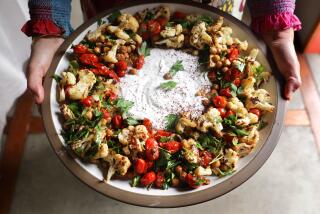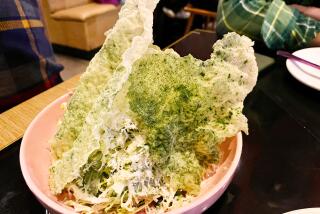Oil and Vinegar Dressing--Hold the Oil
- Share via
These days, the well-dressed salad is not just a bowl of super-fresh ingredients. Good salad dressings are a must to enhance the delicate flavors of lettuce, vegetables and fruit.
Yet trying to keep salads low in fat with homemade dressings is tricky--a classic vinaigrette contains 10 grams of fat per tablespoon. Do bottled diet dressings become a way of life for year-round salad lovers? Or is there a secret to keeping flavor in and fat out?
I’ve found a number of successful substitutions for oil in homemade dressings. The key is to retain the proper balance of flavors. Too much of any one ingredient--sharp, tangy or smooth--can throw the balance off.
In most dressings, the traditional proportion is two parts oil to one part vinegar. I was able to replace up to one-third the oil with defatted broth, a vegetable puree, vegetable juices, blended low-fat cheeses such as ricotta or cottage cheese, nonfat milk and even balsamic vinegar--with no flavor loss.
For example, a recipe that called for 3/4 cup olive oil would become 1/2 cup olive oil and 1/4 cup broth, pureed ricotta, unsalted tomato or vegetable juice, or balsamic vinegar. Automatically, I’ve cut the calories and fat by 30% or more.
*
As I tried further reducing the proportion of oil to other ingredients, I noticed that flavors appeared sharper. Oil acts as a flavor emulsifier, creating a harmonious blend to the taste buds. To keep the balance of flavors when substituting or reducing the oil, I had to reduce the amount of stronger-tasting ingredients such as grated onion, garlic and cayenne pepper; they tasted much more powerful than in the original recipe.
Another result of reducing the oil further was that the dressing was less able to adhere to and coat the lettuce--the essential job of all dressings. A salad dressing is not successful if it pools in the bottom of the bowl. So, to create creaminess, I added a small amount of low-fat plain yogurt or pureed roasted sweet peppers. The bit of fat in the yogurt was much less than the original amount in the oil, and it helped the dressing bind together.
The roasted and peeled sweet red peppers, which are sold in jars in the supermarket, became a staple for my doctored dressings. The peppers lent a grilled or barbecued flavor, a light rose color and--when pureed first--a smooth silky texture reminiscent of fat. Green peppers worked well too, although they were not as sweet as red.
I also discovered that using stronger-tasting oils gave me more flavor mileage. For example, dark or toasted sesame oil can be used in smaller amounts than olive oil, yet the pungent flavor makes the dressing taste richer.
*
The following salad is an example of how the potent flavor of dark sesame oil can be used in a very small quantity to give a big effect.
CHINESE VEGETABLE SALAD
1 large cucumber, peeled, halved lengthwise, seeded, sliced into thin crescents
1/2 head green cabbage, thinly sliced
1/2 cup drained canned mandarin oranges
1 tablespoon grated onion
2 cups chow mein noodles, optional
2 tablespoons sesame seeds
1/4 cup chopped cilantro
Combine cucumber, cabbage, mandarin oranges, onion, noodles, sesame seeds and cilantro in large bowl. Toss Dressing with vegetables. Serve immediately. Makes 4 to 6 servings.
Each serving contains approximately:
200 calories; 719 mg sodium; 0 mg cholesterol; 7 grams fat; 34 grams carbohydrate; 4 grams protein; 5 grams fiber.
Dressing
1/2 cup rice vinegar
1/3 cup honey
1 tablespoon low-sodium soy sauce or tamari
1 tablespoon grated ginger root
1 tablespoon dark sesame oil
1 teaspoon salt
Stir together vinegar, honey, soy sauce, ginger root, sesame oil and salt in separate bowl. *
This tart-sweet winter fruit salad is a wonderful addition to any brunch menu. The idea came from a Mollie Katzen recipe.
SWEET CITRUS SALAD
4 oranges, peeled and sectioned
2 large pink grapefruit, peeled and sectioned
2 ripe kiwi, peeled and sliced
2 tablespoons honey or maple syrup
1/2 teaspoon ground nutmeg
1/2 teaspoon ground cinnamon
3 cups torn leaf lettuce, spinach or greens
1/4 red onion, thinly sliced
1 tablespoon olive oil
Salt, pepper
Place oranges, grapefruit and kiwi in bowl. Toss with honey, nutmeg and cinnamon. Let stand 15 minutes.
Combine greens, onion and oil in salad bowl. Season to taste with salt and pepper. To serve, pile fruit over greens. Makes 4 servings.
Each serving contains approximately:
206 calories; 142 mg sodium; 0 mg cholesterol; 4 grams fat; 43 grams carbohydrate; 4 grams protein; 14 grams fiber.
*
This delicious pasta salad is slightly higher in fat because of the peanut butter, but it is also spicy and warming, perfect for a winter picnic. The dressing is also a delicious marinade for grilled foods.
WARM AND SPICY PEANUT PASTA SALAD
4 cups cooked hot penne or other tubular pasta
1 cup diagonally sliced raw green beans
1 sweet red pepper, seeded and cut into strips
1 large cucumber, peeled, seeded and thinly sliced
1/4 cup chopped cilantro
6 green onions, cut into thin strips
1/3 cup smooth peanut butter whisked with 1/4 cup defatted chicken broth
1 tablespoon dark sesame oil
2 tablespoons low-sodium tamari or soy sauce
2 tablespoons lemon juice
2 tablespoons honey
3/4 teaspoon cayenne, or to taste
1/4 teaspoon ground cumin
1/8 teaspoon ground turmeric
Lettuce leaves
Combine pasta, green beans, sweet red pepper, cucumber, cilantro and green onions in large bowl.
Whisk together peanut butter mixture, sesame oil, tamari, lemon juice, honey, cayenne, cumin and turmeric in small bowl. Pour dressing over vegetables. Toss well to coat evenly. Arrange lettuce leaves in salad bowl and mound salad in center. Makes 6 servings.
Each serving contains approximately:
410 calories; 292 mg sodium; 0 mg cholesterol; 11 grams fat; 66 grams carbohydrate; 14 grams protein; 2 grams fiber.
More to Read
Eat your way across L.A.
Get our weekly Tasting Notes newsletter for reviews, news and more.
You may occasionally receive promotional content from the Los Angeles Times.










